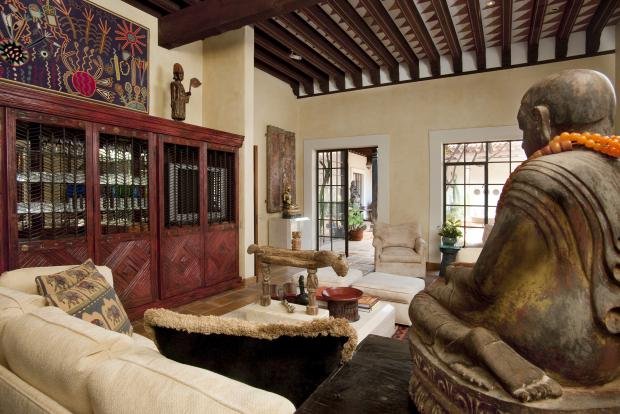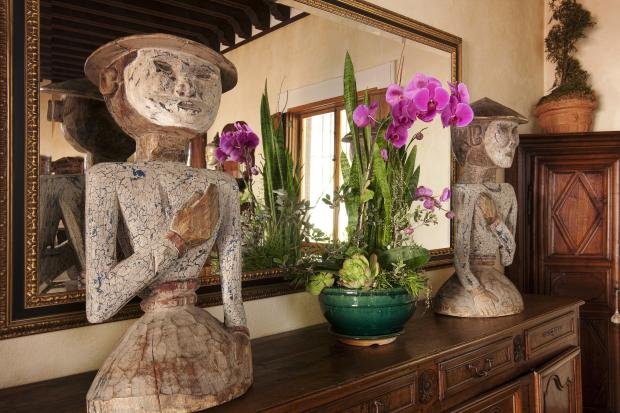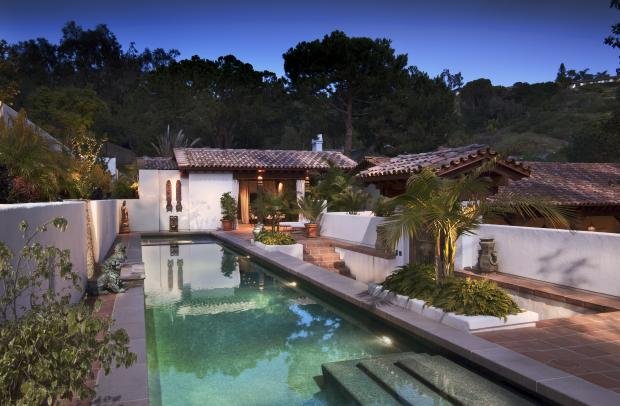SUGAR & SPICE
By Wayne Carlson
In the stately Spanish colonial residence sitting beneath a small grove of pine trees in La Jolla, treasures are displayed around every stuccoed corner and behind every hand-carved door. Under a spiral staircase, an alabaster Thai goddess squeezes water from a long braid of hair. In the family room, a kneeling wood nun from Burma contemplates her own contradiction: Her dour expression does not match her festive amber necklaces. Sweet carved-wood figures of wedding couples from Bali and Thailand warm the adjoining living and dining rooms. At one end of this great room, a tower of African masks spices a support beam. At the other, a red painted wood shrine from Thailand stands in a light and airy corner, its lotus shaped finials gleaming on a sunbeam. The remarkable piece formerly graced the late designer Tony Duquette's Dawnridge residence in Beverly Hills.
Elsewhere, a central Mexico tapestry woven by the mythology-rich Huichol tribe of Indians hangs above a hand-carved Burmese entertainment cabinet that's tattooed with good-luck symbols. And in each perimeter room, overlooking the treasures in the courtyard, are windows reclaimed from an ancient Mexican sugar factory.
When the owners of this spectacular home decided to add a pool and open-air entertaining/dining space, they naturally decided it, too, would be designed with ideas from around the globe, with emphasis on Southeast Asia and Mexico. Since the husband loves Mexican design and the wife adores Asian, the design scheme was a given.
The home was designed 38 years ago by its original owner, author photographer Harry Crosby, a noted authority on Mexico. For guidance on the architecture, Crosby consulted some 200 images he had captured of eight Spanish Colonial residences in Patzcuaro, a town in the Mexican state of Michoacan. He also brought back from Mexico a large cache of building materials, including antique carvedwood doors, stenciled ceiling beams, two carved-stone fireplaces and saltillo tiles that pave both exterior and interior floors. The two-and-a-half-year construction project was completed in 1974.
After the present owner acquired the house from Crosby in the late '70s, he hired George Dewhurst's GDC Construction, Inc., of La Jolla, to fix some structural problems. Through the years, Dewhurst did other work, including the maintenance of columns, ironwork, stucco and the radiant heating under the tile floors.
Dewhurst's son Pancho, vice president of the company, headed up the new pool project, which was launched in 2008. The job's biggest problem, says the younger Dewhurst, was preparing the building site a steep canyon hillside that rose from the back of the lot.
"We had to build a ramp to the street to take out 300 cubic yards of dirt we excavated with a Bobcat," he says. "We had to put in a series of caissons to support the pool and the retaining walls that step up the hillside."
The new project's design was a collaborative effort among Dewhurst, architect Michael Morton and the lady of the house, who, with her husband, asked to remain anonymous for this story.
"She had a lot of great ideas," Dewhurst says. "Like she and her husband, I travel a great deal. We had been to Chichen Itza on the Yucatan Peninsula of Mexico, so we tried to create a Spanish-style staircase that was similar to those on the pyramids there."
To reach the pool, one takes a wide three-step flight of tile stairs to a landing, which features a reclining Buddha from China in a niche in a stucco wall. From there, f lanking symmetrical sets of stairs mirror each other as they climb to converge in front of antique Indian double doors that hang from a tile-covered portico that mimics the roof of the house.
The doors open to reveal a blend of architecture and landscape that mixes Southeast Asian and New World details. Components include a 75-foot lap pool and spa with a state-of-the-art saltwater system and inset into the wall behind the pool a 20-foot stone fountain flanked by a pair of bronze lions that reference a larger pair that stand guard outside the home's main entrance.
On one end of the pool is a covered open-air living/dining space with handcarved wood columns from Southeast Asia not unlike those in the courtyard. Off this space is an open stone shower that was inspired by ones the homeowners had admired in Thailand.
This new construction is so seamless it appears to have been done in the same time frame as the house, which is filled not only with art objects and folk art but also architectural details that are foreshadowed in the 14-foot-high foyer. Here, above hand-carved Mexican double doors, is a scallop detail with gold leaf that is echoed in an art niche in the living room. Hand-painted Spanish ceiling tiles and stenciled ceiling beams are repeated throughout the house. Other items of note here are full-height mirrors that frame iron cabinets designed by the late great mid-century San Diego interior designer Gerald Jerome. With its hand-carved columns and doors, wooden support beams with corbel ends, ceiling tiles, wrought-iron rails, stucco masonry walls, two piece reclaimed Spanish roof tiles, this house is the perfect gallery for the couple's wonderfully exotic collection. The first of the home's two handcarved stone fireplaces can be found in the living room that, with the dining room, constitutes the home's main gallery space for the fabulous art pieces, furniture and accessories the couple have collected in their travels. A major contribution that Harry Crosby made is the home's free-flowing connection to the large courtyard, which has its own collection of treasures, including a centerpiece carvedstone fountain. Crosby designed the floor plan so every main room looks out to the outdoors through the sugarfactory windows. "Our home is not like the big mansions you've seen in Rancho Santa Fe," the comely homeowner had said as she greeted visitors to her house. "It's much smaller than the houses you're probably used to seeing." That may be true, but there remains one certainty about her own residence: It is as much a San Diego treasure as any of the amazing objects and art that it shelters.
The Buzz Categories
- Press
- La Jolla Light
- Awards
- Insights
- Houzz
- San Diego Home/Garden
- La Jolla Village News
- News
- La Jolla Blue Book
- Dwell
- Luxe Interiors + Design
- San Diego Business Journal
- San Diego Daily Transcript
- Best of La Jolla
- Gold Issue
- Modern Luxury San Diego
- Pancho Dewhurst
- Rancho Santa Fe News
- San Diego Magazine
- The Wall Street Journal








